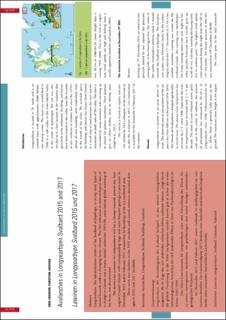| dc.contributor.author | Jonsson, Arni | |
| dc.contributor.author | Jaedicke, Christian | |
| dc.coverage.spatial | Longyearbyen, Svalbard, Norway | en_US |
| dc.date.accessioned | 2023-11-01T17:52:10Z | |
| dc.date.available | 2023-11-01T17:52:10Z | |
| dc.date.issued | 2017 | |
| dc.identifier.isbn | 9783950492453 | |
| dc.identifier.uri | https://hdl.handle.net/11250/3100102 | |
| dc.description.abstract | Longyearbyen, the administrative centre of the Svalbard archipelago, is facing most types of natural hazards under a changing Arctic climate. The first indication in meteorological data of a change in climate was a heavy rainfall midwinter 1995/96, years before global warming of the Arctic was documented. The worst-case scenario in Longyearbyen will be a change towards present day Norwegian Coastal climate with corresponding large and more frequent geological processes. In December 2015 and in February 2017 avalanches hit buildings at the Lia residential area. There were two fatalities in the 2015 incident and caused extensive structural damages in 2015 and 2017 incidents. | en_US |
| dc.language.iso | eng | en_US |
| dc.relation.ispartof | Wildbach- und Lawinenverbau: Zeitschrift für Wildbach-, Lawinen-, Erosions- und Steinschlagschutz | |
| dc.subject | Avalanche-RnD | en_US |
| dc.subject | Snøskred-FoU | en_US |
| dc.subject | Longyearbyen | en_US |
| dc.subject | Svalbard | en_US |
| dc.subject | Buildings | en_US |
| dc.subject | Fatalities | en_US |
| dc.title | Avalanches in Longyearbyen Svalbard 2015 and 2017: Avalanche Protection - Visions | en_US |
| dc.title.alternative | Lawinen in Longyearbyen Svalbard 2015 und 2017: Visionen im Lawinenschutz | en_US |
| dc.type | Chapter | en_US |
| dc.source.pagenumber | 182-187 | en_US |
| dc.source.volume | 81 | en_US |
| dc.source.issue | 182-187 | en_US |
| dc.source.articlenumber | 179 | en_US |
